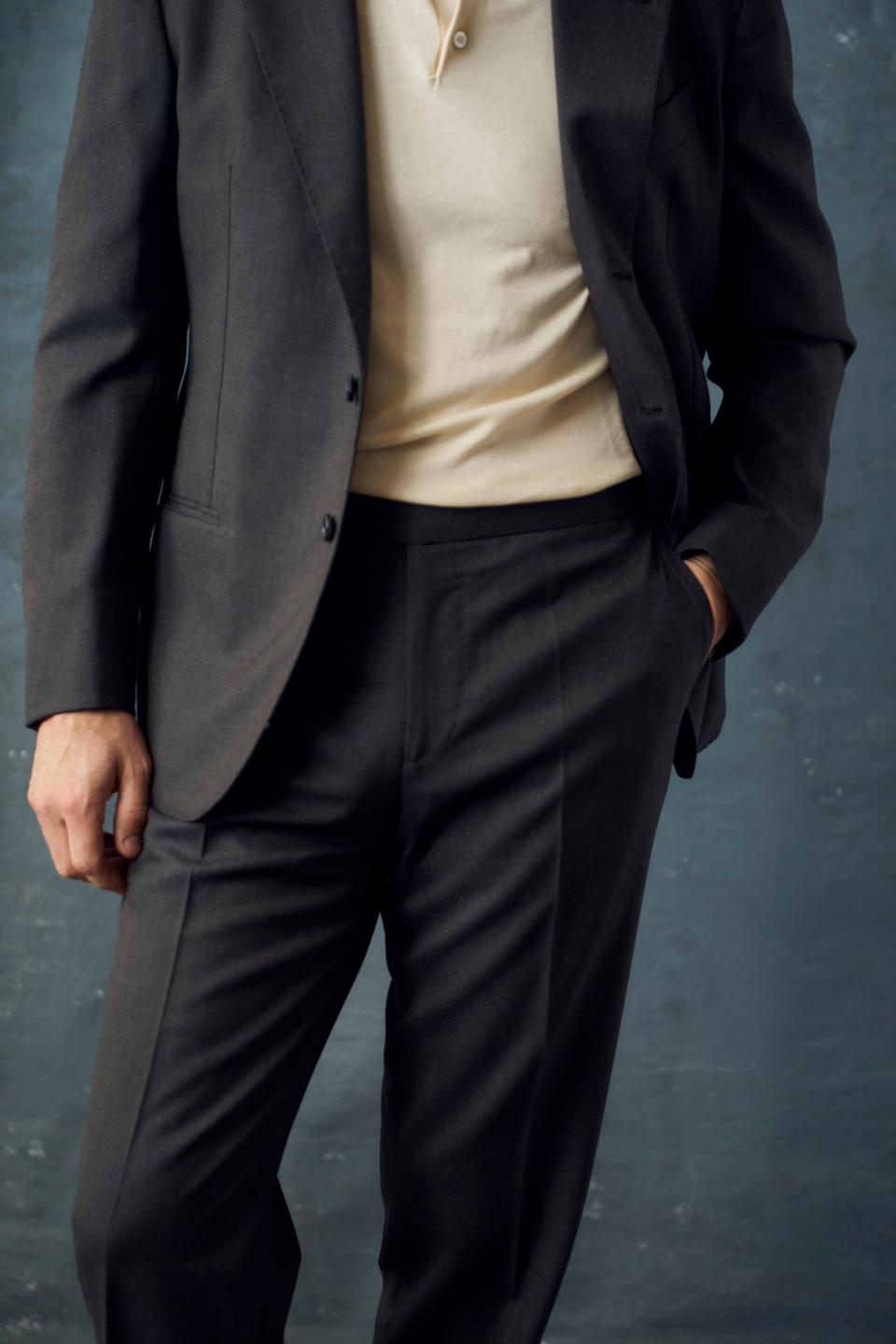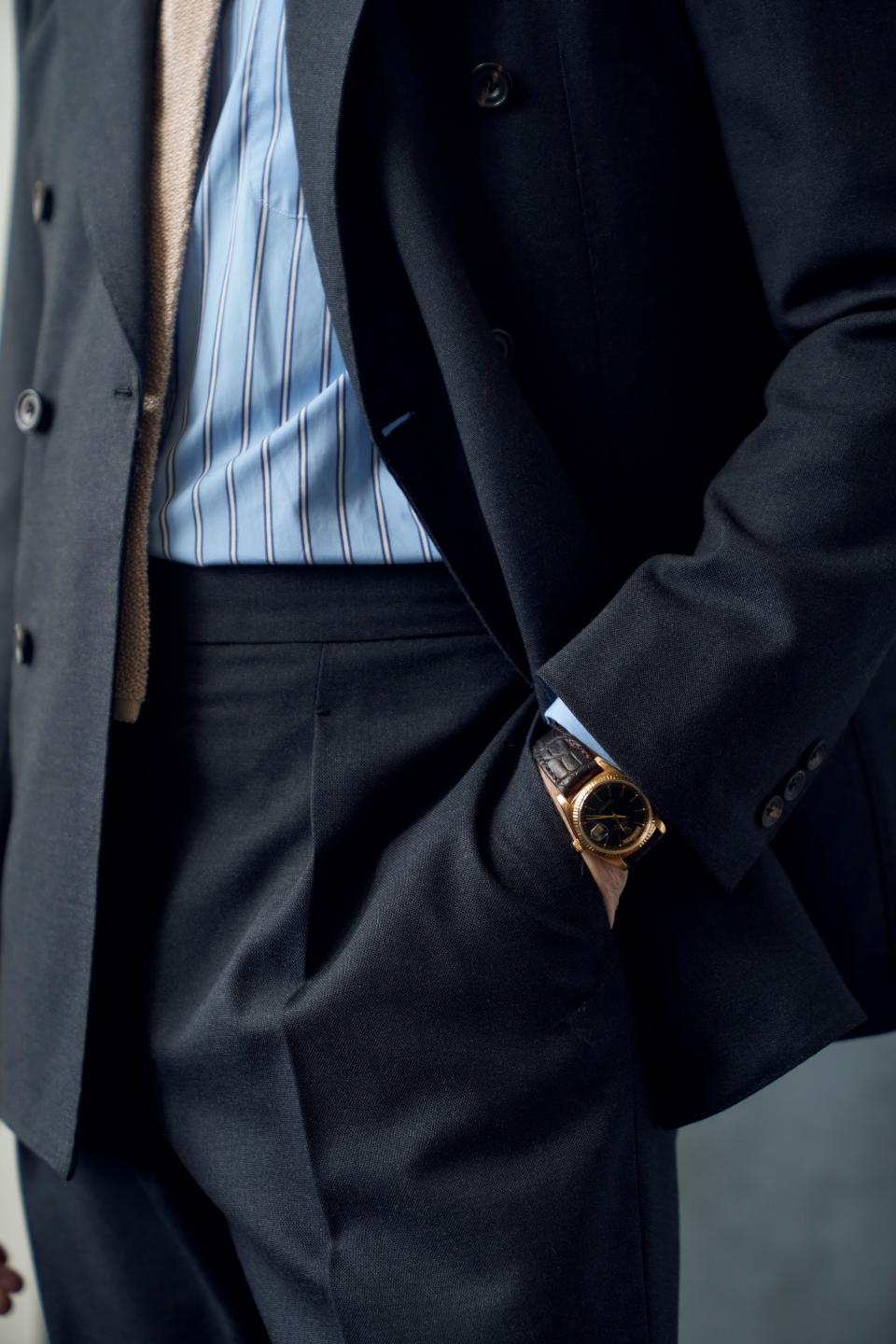This Is Why Your Pants Don’t Fit Quite Right, According to an Expert Tailor

Collage by Armando Zaragoza / Photo courtesy of J. Mueser Bespoke
Shopping for a suit can feel like learning an entirely new language. You go in looking for a simple two-piece, and you wind up trying to decipher what “half-canvassed” means and wondering whether your jacket should have one vent or two. To help you navigate the ins and outs of the tailoring world, we’ll be exploring each individual aspect of a suit—from the fit to fabric to the pockets—with a little help from the most stylish experts in the sartorial space. Welcome to GQ’s Tailoring 101.
When was the last time you felt truly jazzed about putting on a pair of pants? For most people, the answer is likely never. Most everyone understands the power of a tweed blazer or a perfectly tailored suit jacket to elevate your look, but—aside from being the requisite bottom half of your suit—trousers tend to be treated like a minor character in the story of you getting dressed. There’s an easy explanation for this. Unless you have the proportions of a fit model (and if so, kudos) most pants—particularly pants of the non-stretchy variety—are not going to fit quite right. A great pair of tailored wool trousers, however, can do two important things: Make your legs look really good and get you excited about putting on your pants in the morning.
One vent or two? Patch pockets or jetted? And what about buttons?
Single-breasted or double? Three-roll-two or six-by-one? Two elite tailors advise on what looks best.
“It might be the width of the trousers, it could be the way they fall, the style in terms of pleats and side adjusters, different types of waistbands, all of that stuff makes them different from what you’ll buy off-the-rack,” explains Jake Mueser, the founder of J. Mueser Bespoke in NYC. “It’s not like a pair of jeans, where they feel uncomfortable for the first few days until you break them in and shape them to your body. When it comes to tailored trousers you have to get them right.”
Getting them right starts with the right fit, particularly in the thigh-to-waist zone. Most ready-to-wear pants carry measurements for the waist and the inseam (the distance from just below the crotch to the hem) but there are half a dozen additional measurements that determine how a pair of pants will fit. “Things get more complicated where the seat and thigh sit in conjunction with the way the rise is cut,” Mueser says. “A pair of trousers might have the right waist and the right seat and even the right thigh but if the rise is cut too low, then the fork of the pants is going to pull up and that can be quite uncomfortable.” Likewise, if the rise is too high, you might end up with bunching around the crotch and pockets, which won’t look right, either.
“A lot of guys don’t need bespoke trousers, but where you see major issues is someone who has a very athletic form, bigger thighs, a fuller seat, and a narrow waist,” Mueser adds. “This is the kind of guy who’s going to have a lot of trouble finding something off the rack and is really going to benefit from a tailored trouser.”

Whether you’re going off-the-rack or custom-made, the question of rise is an important one. After two-plus decades of ubiquitous low-rise pants for men, waists (and rises) are moving higher, but finding the right rise for you depends both on your tastes and your build. “It’s important to know what you like and what works for your body type,” Mueser says. For anyone whose middle is less six-pack and more mini-keg, for instance, you’ll have to decide if you want to wear your pants under the belly or over it. If it’s the latter, you’ll need to wear suspenders to keep those high-waisted trousers from settling on your hips. “If you're comfortable with the look [of suspenders], then you should go for it,” Mueser says. “Otherwise you might be better off with a lower rise.”
The other important variables include pleats (do you want them? And if so, how many?) cuffs (do you want them? And if so, what size?) and length (do you prefer your pants to “break” on the tops of your shoes or reveal a bit of ankle?) Unlike the more esoteric art of rise and fit, the answer to these questions mostly comes down to personal preference and comfort.
The purpose of pleats, aside from giving your pants a slightly more sophisticated look, is to make them more comfortable, especially with higher-waisted cuts, Mueser explains. Pleats come in single, double and triple varieties, and can be either forward- or reverse-facing, with front-facing pleats being historically more common from English tailors, and reverse-facing ones more prevalent at Italian houses. Whether you want one, two, or three pleats depends mostly on your taste, with one being the subtlest and three being (in Mueser’s opinion) a bit extra. “Pleats give more volume, and in a fuller-cut trouser, more comfort,” he says. “When you have no pleats you can have a sleeker, more tailored trouser.”

The most important thing to know about cuffs is that they are more commonly associated with pleats than flat-fronts, and tend to go with casual pants better than formal ones (cuffs on tuxes are generally a no-no). The good news? Cuffs are relatively easy to remove if you get tired of them in a few years, so there’s little risk in opting in. In terms of size, cuffs usually range from an inch and a half to two inches (Mueser’s preference is 1 ¾”). “You also have to be a bit mindful of your height,” he adds. “A cuff can make the leg look a little shorter, but I don’t think that should be a deterrent, it’s just part of the style.”
If all of the above is gravy, there’s one final hurdle to clear on your way to the perfect pair of pants: the right length. “I think that trousers should have a hint of a break,” Mueser says. “The high-water trouser is certainly an aesthetic choice that one can make, but the most timeless and classic way of cutting trousers is with the slightest break touching the top of the shoe.” Whatever length you opt for, where your pants break ultimately depends on your choice of footwear, so plan on bringing your favorite oxfords, loafers, or sneakers (or better still, all three) when you take your pants in to get hemmed.
Originally Appeared on GQ
More Great Style Stories From GQ
Rolex’s Biggest Release of 2024 Is…
The 20 Greatest Nike Air Max Sneaker Colorways of All Time
Kevin Hart’s Royal Oak Costs More Than a House
Not a subscriber? Join GQ to receive full access to GQ.com.
Every Single MoonSwatch, Ranked



